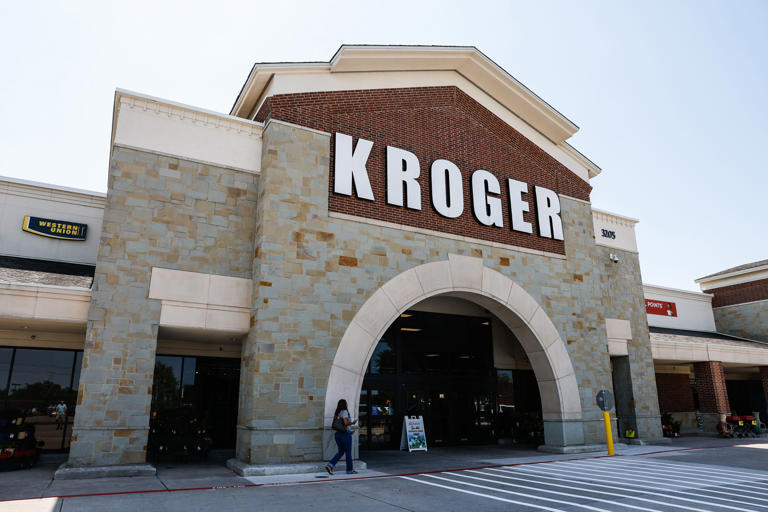The government’s lawsuit against Kroger and Albertsons highlights several key points. Firstly, it defines what constitutes a supermarket and characterizes both companies as “serial” acquirers, indicating a pattern of frequent acquisitions. Additionally, the lawsuit underscores the influence of union representation on the workers within these grocery chains.
While Kroger and Albertsons have previously engaged in major acquisitions, the antitrust regulators are now stepping in to halt their latest merger attempt. The lawsuit, filed by the Federal Trade Commission and nine attorneys general, illustrates the significant disagreement between the government and the companies regarding the proposed $24.6 billion deal, which would represent the largest merger in U.S. supermarket history.
‘Serial acquisitions’
The government’s lawsuit characterizes Kroger and Albertsons as the result of frequent acquisitions, labeling them as “products of serial acquisitions.” It specifically objects to their latest merger attempt, which would bring together the top two supermarket chains in the U.S. Over the years, dating back to 1983, these companies have collectively acquired nearly three dozen grocery store banners, in addition to their own namesake stores. Kroger has acquired 19 banners, while Albertsons has acquired 15.
In Texas, Kroger’s growth has primarily been organic, with the company expanding its presence under its own brand name. On the other hand, Albertsons has made significant moves to increase its footprint in the state. This includes the acquisition of United Supermarkets in Lubbock in 2013, which brought brands like United, Market Street, and Amigos under its umbrella. Additionally, in 2015, Albertsons acquired California-based Safeway, which further expanded its presence in Texas with brands like Tom Thumb and Randalls.
Little chance of success
Kroger heralded C&S Wholesale Grocers as a strong acquirer of 413 stores in 17 states including Texas to satisfy antitrust review. Kroger said C&S will “successfully operate and continue to grow these iconic brands for years to come.”
The FTC said that Kroger and Albertsons structured the sale to C&S with assets that are insufficient to operate a supermarket business that substantially replaces Kroger or Albertsons. Stores sold would be in markets where Kroger and Albertsons overlap.
In the case of Dallas-Fort Worth, the divested stores when separated from the 200 stores now operated by the combined robust operations of Kroger and Albertsons, which includes Tom Thumb and Albertsons, will have little chance of success, the FTC is saying.
Grocery Giant Faces No Risk from Spin-Off, Analysts Say
The FTC expressed concern that the potential failure of C&S Wholesale to operate stores successfully would ultimately impact customers and communities, rather than Kroger and Albertsons themselves. According to the FTC lawsuit, if these neighborhood stores were to fail, it would be the American public, not the defendants (Kroger and Albertsons), who would bear the costs and consequences.
Local vs. national competitors
Kroger and Albertsons argue that the FTC’s decision would benefit larger, non-unionized retailers like Walmart, Costco, and Amazon, ultimately strengthening their dominance in the grocery industry. However, the FTC is focusing on the local level and considers supermarkets as convenient one-stop shops for various needs, including groceries, pharmacy, floral, and gasoline.
Regulators emphasize that limited assortment stores like Aldi and Lidl, as well as organic stores like Whole Foods and Sprouts, offer different customer experiences and cannot fully substitute traditional supermarkets. Wholesale clubs also differ in terms of membership fees, package sizes, and product variety, requiring shoppers to travel farther distances.
Furthermore, the online grocery experience provided by Amazon and other platforms differs from in-store shopping, as customers cannot physically inspect products before purchasing, must plan for delivery or pickup, and may incur additional fees, ultimately affecting the total cost of groceries.
Workers could be short-changed
The FTC’s lawsuit emphasizes how the merger between Kroger and Albertsons would diminish competition for workers. Kroger employs 430,000 workers covered by over 300 collective bargaining agreements with labor unions across 30 states, while Albertsons has more than 290,000 workers, with most covered by unions in 26 states. In states where both companies have unionized grocery workers, such as Alaska, Arizona, California, and others, unions can negotiate better terms for workers by leveraging the fact that Kroger and Albertsons are separate entities.
As an example, the lawsuit mentions a strike by the United Food and Commercial Workers (UFCW) Local 7 against Kroger’s King Soopers supermarkets in Denver in 2022. During the strike, workers urged customers to transfer their prescriptions to Albertsons stores. Kroger eventually agreed to higher wages and safety protections for its workers, and UFCW Local 7 then negotiated similar terms with Albertsons.
This case illustrates how unions can use competition between employers to improve wages and benefits for their members, benefiting thousands of workers in the process.
